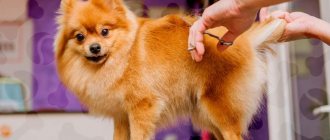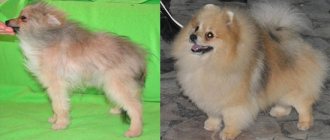Pomeranians are ideal pets for city dwellers with their tiny size and sweet personality.
They are best known for their lively personalities and adorable fluffy coats. However, did you know that the Pomeranian's fluffy double coat can come in over 10 different colors?
There are actually 13 different Pomeranian colors, ranging from pale cream to merle. Perhaps you'll fall in love with their famous orange coat, or maybe you'll love the rare tiger pattern?
Pomeranian Spitz color chart
There are 13 different colors of the Pomeranian recognized by the World Kennel Club.
Some colors, such as beaver and brindle, are less common than the more traditional red, orange, white and black. You can see a complete list of all coat colors in the table below:
| Color | Appearance | Popularity rating |
| orange | Bright orange without black markings. Gradient from light to dark orange. | 1 |
| red | A deep rusty red color with lighter cream fur on the chest. | 2 |
| white | Pure white with no cream or darker markings. | 3 |
| black | Solid black color. | 4 |
| Merle | Splashes of red on a brown base with splashes of white. | 5 |
| Wolf sable | Gray fur with black nose, eye rims, lips and paw pads. | 6 |
| Chocolate | Colors from milk to dark chocolate. | 7 |
| Blue | Silver-gray and dark gray guard hairs. | 8 |
| Cream | Pale fur that looks like a honeycomb. | 9 |
| brindle | With streaks of red, gold, orange and black. | 10 |
| Black and Tan | Fluffy, with black fur on the face and back, with tan on the chest and legs. | 11 |
| Beaver | Light brown in color, reminiscent of a pale cookie. | 12 |
| Tricolor | Black, brown and white pattern. | 13 |
Spitz color chart
Breed standard
An adult Pomeranian at the withers should be 18-22 cm. The weight of a dog to participate in the exhibition should be no less than 1.4 and no more than 3.2 kg, ideally 1.8-2.3 kg.
These dogs should have a dense, strong, but harmonious physique, a square body.
Breed standard:
- wedge-shaped head;
- the skull is small, tapering towards the nose, the stop is poorly defined;
- the muzzle is proportionate to the body, ratio 2:4;
- the nose is small, round, pigmented black or brown - depends on the color of the coat;
- the lips are weakly expressed, there are no folds in the corners of the mouth;
- straight or scissor bite, the absence of no more than 3 premolars is not considered a defect;
- cheekbones are rounded, not protruding;
- the eyes are small, almond-shaped, slightly slanted; the iris is black, and in individuals with brown fur it corresponds to its shade;
- the ears are triangular, pointed at the ends, set high and close, erect;
- croup short, straight;
- the chest is voluminous;
- the tail is bushy, set high and carried over the back;
- the forelimbs are straight, the shoulders are strong, with well-developed muscles;
- cat-type paws, rounded;
- the hind limbs are stocky and strong, set parallel;
- the skin fits tightly to the body, there are no folds.
Disadvantages for which participation in exhibitions is not prohibited include hereditary anatomical defects, an apple-shaped head and a too flat skull, large eyes, a lighter nose, and sudden movements.
NOTE!
Dogs with a crown that is not covered in time, an overshot or undershot eyelid, eversion or inversion of the eyelids, semi-erect ears, or obvious white spots in any color other than white cannot participate in exhibitions.
Pomeranian Spitz
© shutterstock
When dog lovers think of this breed, they think of orange. Breeders call the orange Pomeranian clear orange to distinguish this color from the orange sable. This color was developed by crossing an orange Pomeranian with a sable carrying a pure recessive gene.
These Pomeranians are often puppy-pale. It's a pleasure to watch them ripen and see their color change from pale creamy white to bright orange. Sometimes these puppies' sable coats also turn bright orange.
They typically lack black fur and are a lighter cream color with a gradient of light to dark orange. Orange Pomeranians are very easy to find and are recognized as an acceptable color in their breed standard.
Size varieties
The breed standard specifies the optimal weight for adult representatives of this breed. Thus, the English and American Kennel Clubs consider the standard weight to be from 1.36 to 3.1 kg. On average, the body weight of males should be 1.8-2.3 kg, females - 1.4-3 kg.
Depending on the final weight, representatives of this breed are divided into 3 groups:
- tiny sizes – 1-2 kg;
- tiny toe sizes – 2.25-3.0 kg;
- tou sizes – 3.25-3.5 kg.
Some individuals stop gaining weight before even reaching 1.36 kg. Such miniature dogs require special conditions of maintenance and care.
Red Pomeranian Spitz
© shutterstock
The coat of a red Pomeranian is a dark red rusty hue with lighter cream fur on the chest. It is often confused with the subtler orange.
Red is one of the many colors that can be displayed in a ring. From a genetic point of view, they are similar to black Pomeranians because both colors belong to the E locus gene.
Red and orange are one of the two most popular colors.
White Spitz
© shutterstock
White Pomeranians are pure white with no cream or dark markings.
If you like the look of the Samoyed but want a smaller breed, then this white dog is perfect!
They are born white as puppies and remain this color throughout their lives.
White oranges are white due to the lack of pigment. They do not have the dark pigment melanin (i.e. black eumelanin) that dogs typically have. Due to a lack of pigment, albino animals have red eyes or pink noses. However, a white Spitz is not an albino because its eyes and nose are black.
This adorable Cloud Dog is perfect for anyone who dreams of owning a furry pet and requires the same care, exercise and nutrition as any other color Pomeranian.
Character and temperament
The Pomeranian is a good-natured, affectionate pet who is interested in everything that surrounds him. These dogs are curious and will not refuse the opportunity to learn something new.
Representatives of this breed are characterized by a positive attitude towards life and irrepressible energy. Those who are used to leading a calm and sedentary lifestyle or simply do not have enough free time to communicate and exercise with their pet should not get these dogs - Pomeranians love active games and long walks.
They are very attached to the owner and easily adapt to his usual way of life - the pet will not wake up the owner in the early morning if he is used to sleeping for a long time, but as soon as he wakes up, the dog will follow on his heels.
Thanks to their sociability and ability to capture people's emotions, these dogs get along with all family members, including children - Pomeranians happily play with kids and become their best friends.
IMPORTANT!
Representatives of this breed are very fragile, so they should not be owned by families with children under 5-7 years of age - a child may inadvertently injure the dog.
Pomeranians are wary and suspicious of strangers and will always inform their owner about a stranger’s visit with a loud bark, which makes them good watchdogs. In addition, these dogs are fearless, so without hesitation they will rush to protect the owner if something threatens him.
It is important to raise a dog correctly and from an early age, immediately showing it who is in charge in the house. Pomeranians tend to be dominant, which can become a problem as the pet grows up.
Black Pomeranian Spitz
© shutterstock
This Pomeranian is an adorable solid black color.
Known by fans as creatures of darkness, they still have the signature feisty spirit that we love about the breed.
The black color is created by the E Locus allele gene, which increases the production of black pigment and results in a solid black Pomeranian.
Be careful when taking your black Pomeranian outdoors, as the sun will gradually discolor their fur and result in a reddish-brown coat.
This color is perfect for those who like to wear black clothes as the fur that falls out will remain hidden!
General recommendations for choosing a name for a dog
Having appeared in a new home, the puppy will quickly show its essence. Owners will notice character traits, based on which they can choose a nickname. Here are some simple tips that will help in this difficult matter:
- It has been proven that dogs' hearing perceives voiced sounds better than dull sounds;
- Don't choose a long word for your nickname, 2-3 syllables is ideal. Complex nicknames sound beautiful and unusual, but the dog is unlikely to respond to it, and the owner will be able to quickly pronounce it on the street;
- You should not choose obscene, offensive or funny names. Perhaps at home it is convenient for people to call their dog whatever they like. But you also have to call by nickname in public places where other, strangers are present. What if you end up feeling embarrassed or embarrassing those around you?
- The dog's name should sound clear. Do not call your pet commands that you will later teach him at training grounds. This will lead to confusion for the dog in the future.
Phonetic features
A dog's hearing perceives a variety of sounds much more acutely, especially when walking on the street, where there is so much noise around. A short, simple nickname will help train your pet to quickly respond and come to the command “Come to me!” while walking. And this is very important, especially if the risk of a dangerous situation increases.
The letters “r”, “zh”, “d”, “yu”, “h” help the nickname sound clear. Dogs respond significantly worse to hissing consonants “s”, “sh”, “sch”, “x”. Experts recommend coming up with a nickname that begins with a consonant sound. Call your pet by name as often as possible, and he will get used to it faster. The main thing is to do it affectionately and naturally. Use the name often during games or practices.
Spitz merle
© shutterstock
Merle is a beautiful color pattern because the fluffiness of the Pomeranian's coat shows splashes of red on a brown base with splashes of white. This coloration is very similar to the Australian Cattle Dog. They are often seen as blue or red merles.
Their nose and paws are often variegated shades of pink and black, and their eye color can range from dark brown to blue.
This specimen was bred by mating a merle parent to a black or chocolate Pomeranian.
Make sure your breeder understands the risks associated with breeding Merle dogs. The Double Merle can be very susceptible to deafness or blindness. This is because the double merle gene suppresses certain pigment cells in the iris and cochlea.
This color will wow everyone at the dog park and is perfect for those looking for a splash of color on their pet.
How to choose your future pet?
It is best to purchase a puppy in a specialized nursery from trusted breeders who value their reputation - this will eliminate the possibility of buying a purebred or sick pet.
It is important to inspect the living conditions of the dogs, meet the puppy’s parents, find out about their health and titles if we are talking about buying a breed or show-class pet.
It is also necessary to carefully examine the puppy itself. In a healthy standard dog:
- shiny coat without bald patches and dandruff;
- clean skin without rashes, inflammation and scratch marks;
- there is no increased lacrimation, discharge from the nose and eyes;
- ears are clean, without unpleasant odor;
- pink mucous membranes;
- not bloated belly;
- scissor or straight bite.
The puppy must be active, cheerful and inquisitive; aggression is unacceptable.
Reference! The size of the puppy should not determine the choice - even the smallest pet can grow up to be a large dog.
You should also decide in advance about the gender of the dog - its character largely depends on this. So, males are more stubborn and independent, while females are more obedient, more affectionate, and easier to train. In addition, if there are plans for the pet to participate in breeding the breed, then the choice should be a girl.
Spitz sable color
© shutterstock
The wolf sable Pomeranian is sometimes called the gray sable because it looks very similar to the gray but has black-tipped guard hairs.
This gray variety has a sable pattern, which gives them a black nose, eye rims, lips, and paw pads.
The darkest parts are often the face, back and chest.
Wolf sable is one of the rarest Pomeranian colors and many are mistaken for orange sable. Finding a purebred Wolf Sable Spitz is incredibly difficult, even though the first one was shown in 1901.
The only way to be sure your puppy is a Sable wolf is to take a color gene test.
Unsuitable
Listening to friends or following fashion, some owners call their dogs completely inappropriate names:
- Human - this contradicts moral prejudices. In addition, according to the canons of the Christian Church, this is a sin. Behind every human name there is a saint, so it is considered an insult to call animals that way. By naming a dog this way, you can accidentally hurt the feelings of relatives or good friends;
- Complex, long - the breeder gives the puppy a name consisting of several words, including the name of the kennel. It is used for official documents, but it is inconvenient to use the nickname every day. Usually owners come up with pet names for their pets. The main thing is that the nickname is easy to pronounce, especially when walking, and easy for the animal to perceive;
- Funny, obscene - some nicknames can cause outright embarrassment to others, so sometimes it will be uncomfortable for the owner himself. But a name is for life, so choose it using common sense;
- Names of deceased pets - a new animal can never completely replace the old one. Another dog is a new story in the life of the owner. Therefore, leave the memory alone, start with a clean slate, calling the dog by a different name. There is an opinion that a dog named after a departed four-legged friend risks repeating his fate. Is it worth taking risks and experiencing the Universe?
Chocolate Pomeranian
© shutterstock
Chocolate Pomeranians can range in color from milk to dark chocolate, and their nose and paw pads are often the same silky brown color.
The chocolate color is caused by the B Locus gene, which creates a black pigment that darkens a dog's coat. The mutation dilutes this pigment and results in a chocolate-colored coat.
Like many dogs with darker coats, they do best when not exposed to direct sunlight for long periods of time. Sunlight will redden the coat and make it harder to see the chocolate color.
This dog is a great choice for any owner who wants to walk a teddy bear.
Proper nutrition
The issue of feeding must be approached very responsibly, understanding that the health of the dog directly depends on your decision. Don't be greedy, selfish, remember that a pet will never be able to tell where it hurts. Only a person has the ability to foresee certain moments, so he should try to calculate his steps whenever possible. Experts recommend choosing one thing: natural feeding or dry food. The owner must decide immediately and try not to mix these two methods. You should never skimp on the quality of industrial feed. After all, treating an animal in a veterinary clinic will cost many times more. Dry food should not be lower than premium class. If you are not limited on funds, then it is preferable to choose one with a higher percentage of meat ingredients.
Blue Spitz
© shutterstock
This Pomeranian is born silver-gray and has dark gray guard hair with a blue undercoat.
Blue is a color recognized by the American Kennel Club and is easy to admire.
Blues are bred from two solid-colored parents who carry a diluted gene.
There are health concerns associated with any blue dog because they have a chance of hair loss caused by dilution of the color, leading to hair loss and dry skin.
A blue Pomeranian purchased from a reputable breeder will make a wonderful companion.
Rare colors
The colors listed above are recognized, albeit sometimes with a stretch, by all federations and clubs. However, there are many other options with which everything is not so clear. Less picky federations are willing to accept them, while others prefer to operate exclusively with standard and long-recognized colors.
Rare colors are usually a combination of several standard ones, but still we should talk about them in more detail.
The sable color is very elegant
Vivid examples are the orange-sable and red-sable varieties. Usually puppies are born almost black. Very often, even experienced dog breeders classify them as gray-black with a slight admixture of red. However, with age, the color changes - the gray and black shades recede, but the red color becomes more and more common. As a result, by the age of one and a half to two years, a mature Spitz is simply unrecognizable.
On a note! According to the standard, all Spitz dogs must have black noses. The only exception is the chocolate color - such a Spitz may have a brown nose. In addition, in winter the nose may acquire a lighter color - this is not considered a defect.
A difficult case is the patikolorny (also known as colored) color. The main color of the coat is completely white, without any specks or shades. But spots of different colors may be scattered throughout the body: red, brown and black. Moreover, it is desirable that they are located completely symmetrically. Although this is not a strict condition, at exhibitions judges usually give preference to just such individuals. But the coat color is considered a fault - if the colored zones are almost completely absent, and there are barely pronounced specks on the paws and face.
Cream Pomeranian
© shutterstock
The Cream Spitz is a beautiful dog with light fur. This cream-colored dog is often born white, but after a few months its coat darkens to cream.
One of the genes involved in creating the cream color is the E Locus gene, which also gives the red Pomeranian color.
This color variety requires careful grooming as their fur shows up easily on clothing.
Nicknames for dogs of Spitz girls
So what everyone in the household has been waiting for so long has happened - a new family member has appeared! Your four-legged friend should also have a name. The dog's name should fully personify its nature and temperament. And also sound decent and beautiful. Whatever you name the boat, that’s how it will float – so take your choice of name seriously. We have prepared for you several options that you can use and some recommendations that will help you come up with a sonorous nickname for girls yourself. So let's get started!
brindle spitz
Brindle pattern dogs have stripes of red, gold, orange and black.
The Pomeranian's long coat serves as a canvas for layers of earthy tones.
Brindle is more of a pattern than a color and results in dark stripes. The darkest spots are usually the paws, ears, muzzle and back.
Some are more gray in color and some are brown.
The brindle pattern is caused by the recessive "EE" E Locus genotype.
Each brindle color is different, so you can be sure to get a unique dog.
Black and tan Spitz
© shutterstock
The Black and Tan Pomeranian is a color variety with a black and tan pattern. They are fluffy, with black fur on the face and back, and tan on the chest and legs.
Light brown highlights highlight the breed's characteristic pointed eyebrows and give them a sweet and charming appearance. Many have adorable dotted markings above their eyes that resemble eyebrows.
Charming and sassy is the best way to describe this color.
They are very similar in genetics to sable Pomeranians, as they share the same recessive allele.
Black and Tan Pomeranians are unique and look similar to the smaller Rottweiler or Doberman Pinscher.
Anyone who loves the appearance of these breeds but prefers to have a dog that is suitable for apartment living will be delighted with this dog.
Blooming names
Of course, your dog will always be the most beautiful dog for you. A nickname inspired by the world of flora, namely flowering plants, can reflect her delicate beauty:
- Abelia;
- Acacia;
- Anemone;
- Aster;
- Begonia;
- Brassia;
- Browallia;
- Brunner;
- Vallota;
- Verbena;
- Carnation;
- Geranium;
- Gloxinia;
- Hydrangea;
- Dicentra;
- Ixora;
- Morning glory;
- Kalanchoe;
- Calendula;
- Clarkia;
- Cleome;
- Clivia;
- Crossandra;
- Cosmea;
- Kufeya;
- Lavender;
- Lavatera;
- Lantana;
- Lily;
- Lobelia;
- Daisy;
- Medinilla;
- Mimosa;
- Muscari;
- Nasturtium;
- Nerine;
- Passionflower;
- Pelargonium;
- Petunia;
- Primrose;
- Rose;
- Chamomile;
- Rudbeckia;
- Ruellia;
- Salvia;
- Saintpaulia;
- Tydea;
- Torenia;
- Violet;
- Fuchsia;
- Hathiora;
- Hosta;
- Chrysanthemum;
- Zinnia;
- Evening primrose;
- Echinocea;
- Jacobinia.
Primrose is someone’s favorite flower.
Perhaps among the “fluffy” nicknames there are not yet some suitable nicknames. Surely a couple of interesting options have already popped into your head. Write your ideas in the comments to this article, and together we will add to this list!










